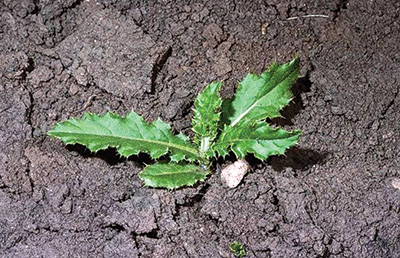Stem
- Up to 4 ft. tall, green to brown, branched at the top and usually lacks hair (glabrous)
Leaves
- Alternate, oblong or lance-shaped, 2-8 in. long, shiny and lack hair; NO leaf stems (petioles); leaf edges (margins) are wavy, lobed or toothed with spiny edges

Canada thistle rosette
Flower
- Pink, purple or white; occur in clusters at the ends of branches; base of flower is vase-shaped, 0.5-0.75 in. wide, lacks prickles and is covered with green to purple bracts with dark tips

Canada thistle flowers
Root
- Deep, extensive creeping root system
Other
- Grows best in moist areas; often found in pastures, hay fields, waste areas and along waterways; known to occur throughout Nevada
- Perennial; reproduces by both roots and seed; plants often appear in patches or colonies due to the spreading root system
Control
- Repeated mowing, tillage, cutting or hand removal prior to seed production can provide suppression
- Several biological control agents are available
- Apply aminocycloprachlor, aminopyralid, chlorsulfuron, clopyralid or picloram pre- or post emergence; repeated applications of 2,4-D, dicamba or glyphosate to actively growing plants
Blecker, L., Creech, E., Dick, J., Gephart, S., Hefner, M., Kratsch, H., Moe, A., Schultz, B.
2020,
Nevada Noxious Weed Field Guide – Canada thistle,
Extension, University of Nevada, Reno, Field Guide


